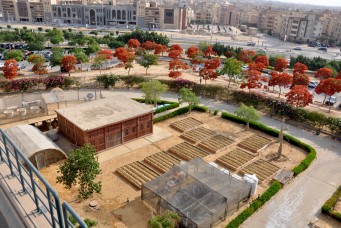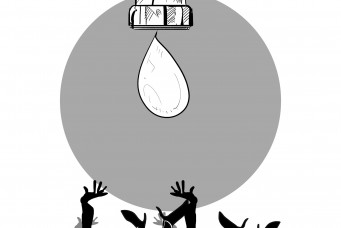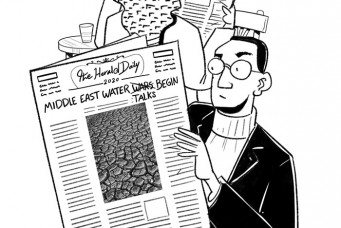The Cost of Clean Water
How one village was hit by the demands of sustainable development.

A CARES consultant measures iron levels at an oasis water station after the organization installed an overflow pipe to improve water quality, Western Desert, Egypt, 2018. Beni Köhler
Anytime a resident of Othman Ibn Affan, a small farming village a seven-hour drive from Cairo, opened the taps at a water station, drinkable water flowed into their twenty-liter jerrycans. For seven months, this is exactly what happened—the water flowed. But in February 2018, something changed. Residents refused to pay for their share of water, and the clean water, which development workers labored years to bring to villages across Egypt’s Western Desert, quickly became unsafe to drink.
The water stations—located in palm-filled villages that punctuate miles of desert land west of Cairo—are built by a research center housed at the American University in Cairo’s Institute for Global Health and Human Ecology called the Center for Applied Research on the Environment and Sustainability, or CARES. Since 2014, CARES has built a total of eighteen water purification stations, primarily in the Western Desert. The CARES stations are part of a mosaic of efforts to develop Egypt’s rural areas, which are informed by a contemporary brand of sustainable development. Development officials and NGO workers today believe the best strategies to pull people out of poverty can balance social equity, environmental health, and economic viability. This began in the 1990s as a reaction against market-led development that only promoted economic growth.
Egyptian governments since late president Gamal Abdel Nasser have invested in greening the desert, and the oases became targets of several desert development projects. Roughly 350,000 persons were resettled between 1987 and 2003. Heavy subsidies and the promise of available reclaimed farmland lured corporations to these newly constructed desert homesteads. As the population grew, how to get clean water to residents while the number of large farms increased became a key question that would puzzle researchers and development organizations for years to come.
Until the mid-1980s, oases residents gathered the bulk of their drinking water from free-flowing wells around fifteen meters deep. After decades of development initiatives by the Egyptian government and international organizations, the desert landscape changed. The population of oases increased, and investors planted orchards of fruit trees beside the blacktop of a long highway completed in the early 1980s. Throughout this period, the government drilled drinking wells and built its own drinking water stations. As the population of investment properties and people grew, the shallow wells began to dry up.
When that happened, residents began to drink from deeper wells, in which they frequently had to drill up to 150 meters to reach water. The deeper water was so full of iron that it flowed red, permanently staining the galabeyas of anyone who cooled off with a swim in a well or canal. It even reached levels over forty times the acceptable amount set by the World Health Organization and Egypt’s Ministry of Health.
Additionally, the iron-saturated water created a health hazard for the oases’ populations. Residents started getting kidney stones. On a given day at a major oasis hospital, as many as five hundred patients could be undergoing dialysis at the same time.
American University in Cairo professor Tina Jaskolski and CARES engineer Hassan Husseiny needed to find a solution. The German professor and Egyptian engineer have worked together on sustainable development projects at CARES for over a decade. The pair figured out that standard filtration systems would not work: even if tablets and filters were available in these remote areas, the groundwater’s iron content would be too high to effectively use them. Filters clogged and were completely dyed in orange after just ten days in the desert. The solution was to build sustainable water purification stations. On the inside, they would all have a one-thousand-liter tank to hold water, filtration devices, and several meters of pipes. One of these pipes would run through the station wall to several taps mounted outside.
The stations’ first function was to remove high iron levels from water. Clear water also meant that the incidence of kidney stones was lowered. Their second function was to kill bacterial and viral contaminants, like E. coli, that cause diarrheal diseases and other health problems. This was achieved through partnering with a German start-up called Autarcon that developed a technology to generate chlorine from the water itself.
In 2016, Jaskolski and Husseiny were able to complete nine water stations with support from three different donors. However, post-construction money was not available; most donors preferred sponsoring public works such as newly constructed stations but following that up with paying for maintenance, including providing replacement parts, was less common. Without donor support, sustainable development projects commonly solicit funds from the communities themselves. The organization collects funds to cover the operation cost of the station. CARES does not sell the water or make a profit from the stations.
Jaskolski and Husseiny planned to set the water price at rates the villagers could afford. Payments would then be channeled to buying replacement parts. After being freely available, in February 2018 residents of Othman Ibn Affan, however, had to pay for their water because sustainable development demanded it.
But residents didn’t pay. Water consumption dropped 90,000 liters in one month. Instead, they preferred to either drink from their taps or zirs, or collect water from a free station. Eventually, the station became unused, and the water content rapidly began to change. In September 2018, Jaskolski’s chlorine testing revealed suspiciously and consistently low concentrations in many stations showing “???” on the measurement device. Without frequent purchases, the water sits in the station tank and the chlorine gets used up fighting bacteria and viruses. The water would be free of contaminants when residents took it from the station. However, there would be no chlorine in the water to continue killing potential disease-causing bacteria once residents gathered the water in jerrycans—it was not safe to store at home.
After realizing the link between water consumption and water quality, CARES’s staff implemented a technical fix on all stations. They installed a chlorine sensor and overflow pipe. If the chlorine level dropped to an unsafe level, water would automatically cycle through the system again.
Not all villages had this problem. Over half of all CARES stations still provide free water. Some stations with card systems have earned enough funds to purchase replacement pumps. However, these stations are in more densely populated areas and closer to highways. For example, one station right next to the highway receives a good amount of income from fruit company trucks who fill up at this convenient location. “For the villages that sell water for free,” Jaskolski tells the Cairo Review, “the question of whether it is sustainable or not is whether they can pay for a part when it is broken. This could be either through money collection from everyone, one rich person buying the part, or someone donating it. If they manage to fix it alone, then they have made it through the sustainability crisis.”
Othman Ibn Affan narrowly surpassed the crisis point. Jaskolski, who has continued to visit, sees some positive changes. “Othman Ibn Affan now has twenty-seven families that are cardholders and has made LE 1,000 in one and a half years,” she says, adding that reestablishing villagers’ trust in the water system takes time. To do that, every month Jaskolski would talk to people and try to convince them to buy water. “Some people we talked to around the station last time had never tried the water, even when it was free.”
All in all, CARES’s experiences demonstrate the limits of sustainable development. It relies on economic sustainability—someone always has to pay. The money generated by the station must keep it running, whether it is donated by a wealthy family, collected by the community, or paid by large companies.
For now, Othman Ibn Affan has collected the equivalent of $61 through a prepaid card system to pay for water and save for future replacement parts. But these stations and card systems will cost several thousand dollars to replace once the parts wear out. In 2018, CARES held a conference and countless meetings with station operators about this but the questions on development workers’ minds remain the same: what about villages without sponsorship from a wealthy family or those tucked far away from the highway? How could a water station be economically sustainable in those areas? How can the cost of clean water be affordable to all?
Zander Pellegrino is a reporter-researcher at the Cairo Review of Global Affairs.
Read More



